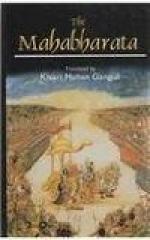97. I expand this verse a little for making it intelligible. A literal version would run as follows: Good means may be seen, perceived as by bees. Action is (cleansed) understanding; through folly it is invested with the symbols of knowledge. Karmabudhhi never means ’action and knowledge’ as rendered by Telang. Abudhitwatt means ‘through ignorance.’ This ignorance is of those persons whose understandings have not been cleansed by action.
98. What is stated here is this. In the matter of achieving Emancipation, no ordinances have been laid down, positive or negative, like those in respect of other things. If one wishes to attain to Heaven, he should do this and abstain from the other. For achieving Emancipation, however, only seeing and hearing are prescribed. Seeing implies contemplation, and hearing, the receiving of instructions from the preceptor. Nilakantha explains hearing as Vedantadisravanam (vide his comment on the word ‘srutam’ in verse 3 above).
99. The speaker wishes to inculcate that one should first contemplate an object of direct perception, such as earth, etc. Then on such ‘unperceived’ objects as operations of the mind. Such contemplation will gradually lead to that which is Supreme. The abhyasa or practice referred to in the second line is the practice of sama, dama, etc. I do not think that Telang’s version of 8 and 9 brings out the meaning clearly.
100. The sense is that when her individual soul became merged into the Supreme soul, she became identified with Brahman. This, was, of course, due to the knowledge of Kshetra as something separate from Kshetrajna.
101. Their origin is Brahman or Truth. They live, dissociated from their origin, in consequence of their acts. When their acts cease, they return to and become merged in Brahman.
102. i.e., that course of life which has for its object the acquisition of knowledge relating to the soul. This, of course, includes the knowledge that is needed for achieving identification with the Supreme Soul or Brahman.
103. The specific characteristics of the five elements are, as frequently referred before, smell attaching to earth, sound to ether, taste, to water, etc. The deities referred to in the last verse are probably the senses.
104. The total eleven is made up of the three qualities, the five elements, the group of organs and senses as one, egoism and understanding.
105. Anyatha pratipannah is explained by Nilakantha as ’born in other orders’. Telang takes it as ‘Behaving in a contrary way.’ ’How can goats and sheep behave otherwise?’ The sense seems to be that those born as goats, succeed in ascending upwards through the efficacy of the religious acts of the Brahmanas. By becoming sacrificial victims they regain their true position.
106. Qualities abiding in Darkness etc, imply those qualities that are permanently attached to Darkness.




